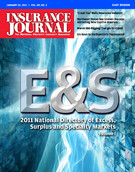Trade Groups Lash Out at Proposed FDNY Charges for Accident Response
The insurance industry spoke out against what it is calling a hidden “crash tax” during a public hearing in New York City earlier this month.
Under the proposal, the city would charge between $365 and $490 to respond to auto accidents — money that would be billed to drivers or insurers, but is generally not covered by standard auto insurance policies. Insurance trade groups said that the fees, if insurers covered them, would drive up the cost of auto insurance premiums in the city.
“While it is understandable that with tight budgets, city officials are looking for ways to increase revenue without increasing taxes, but charging for emergency services is not the answer,” said Kristina Baldwin, assistant vice president for state government affairs at the Property Casualty Insurers Association (PCI). “Public safety is the primary duty of local government and firefighting services are already paid for through property and other local taxes. By billing for these services, the city imposes a hidden, double tax on consumers that could ultimately increase the cost of insurance… The fee literally and figuratively adds insult to injury.”
In testimony, PCI said similar programs have been dropped in several areas of the country and 10 states — Ala., Ark., Fla., Ga., Ind. La., Mo., Okla. Pa. and Tenn. — have passed laws banning accident response fees.
The New York Insurance Association, a trade group for insurers in the state, said that the fees defy the principle that public safety services are covered by the municipal budget.
“If the fire department responds to a residential fire, no bill is ever sent to the resident,” said Ellen Melchionni, the association’s president. “If a city police officer responds to a domestic disturbance or business break-in, a bill is never sent. The fees are an unnecessary imposition of additional costs on New Yorkers who are struggling financially and plagued by taxes.”
Melchionni’s testimony pointed to the experience of Quincy, Massachusetts, a suburb of Boston, which last year implemented accident fees as a way to boost budget gaps. It was only able to raise about $2,700 in fees through the first half of its fiscal year — despite predictions that it could raise up to $250,000 or more.
Several other communities with accident fees have also seen the amount collected fall short of expectations, Melchionni said. Cleveland, for example, has billed over $2 million for accident fees but collected only $117,000.
Insurers said the practice is akin to the days of the late 18th century, when insurance companies had their own fire companies and fire marks were used to distinguish properties that were insured from those that were not.
“To the extent that insurance does pay the fees, such payments will become costs that will need to be covered by future insurance rates,” said David F. Snyder, vice president and associate general counsel for the American Insurance Association. ” New York insurance law and practice provides that to the extent insurers are obligated and make such payments, the costs could go into the basis for determining insurance rates.
“The double payment by only some of the people for a general public good, therefore, is not avoided whether the individual pays the fees or her insurance company pays the fees,” Snyder added. “We believe this kind of fee-based emergency response system was rejected long ago for very good reasons and should not be resurrected now.”
Insurers said the fees could prove dangerous to the public welfare if injured people are fearful of fees when notifying emergency officials.
The proposal comes as the city tries to grapple with a sizable budget hole that officials say could affect the emergency services in the city.
New York Mayor Michael Bloomberg does not need approval of the city council to institute the fees, which could happen as early as next month.
Was this article valuable?
Here are more articles you may enjoy.


 Progressive Q2 Net Income Skyrockets Over 320%
Progressive Q2 Net Income Skyrockets Over 320%  Deere Retreats From Diversity Measures After Online Attacks
Deere Retreats From Diversity Measures After Online Attacks  Wall Street Pushes Back After Activists Escalate Protests
Wall Street Pushes Back After Activists Escalate Protests  Surplus Lines Commercial Growth; Fla. Litigation Costs Reach New High in 2023
Surplus Lines Commercial Growth; Fla. Litigation Costs Reach New High in 2023 


